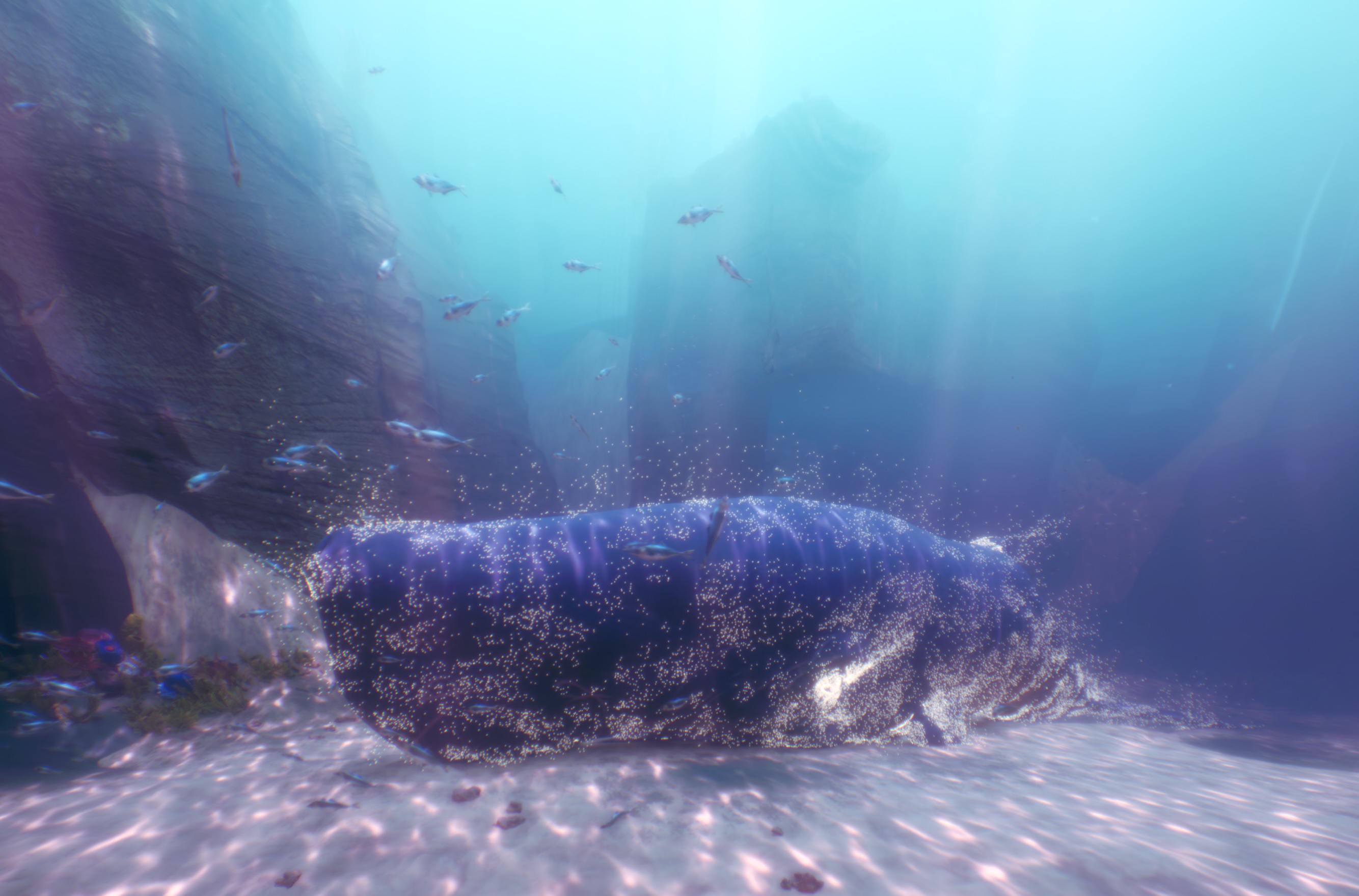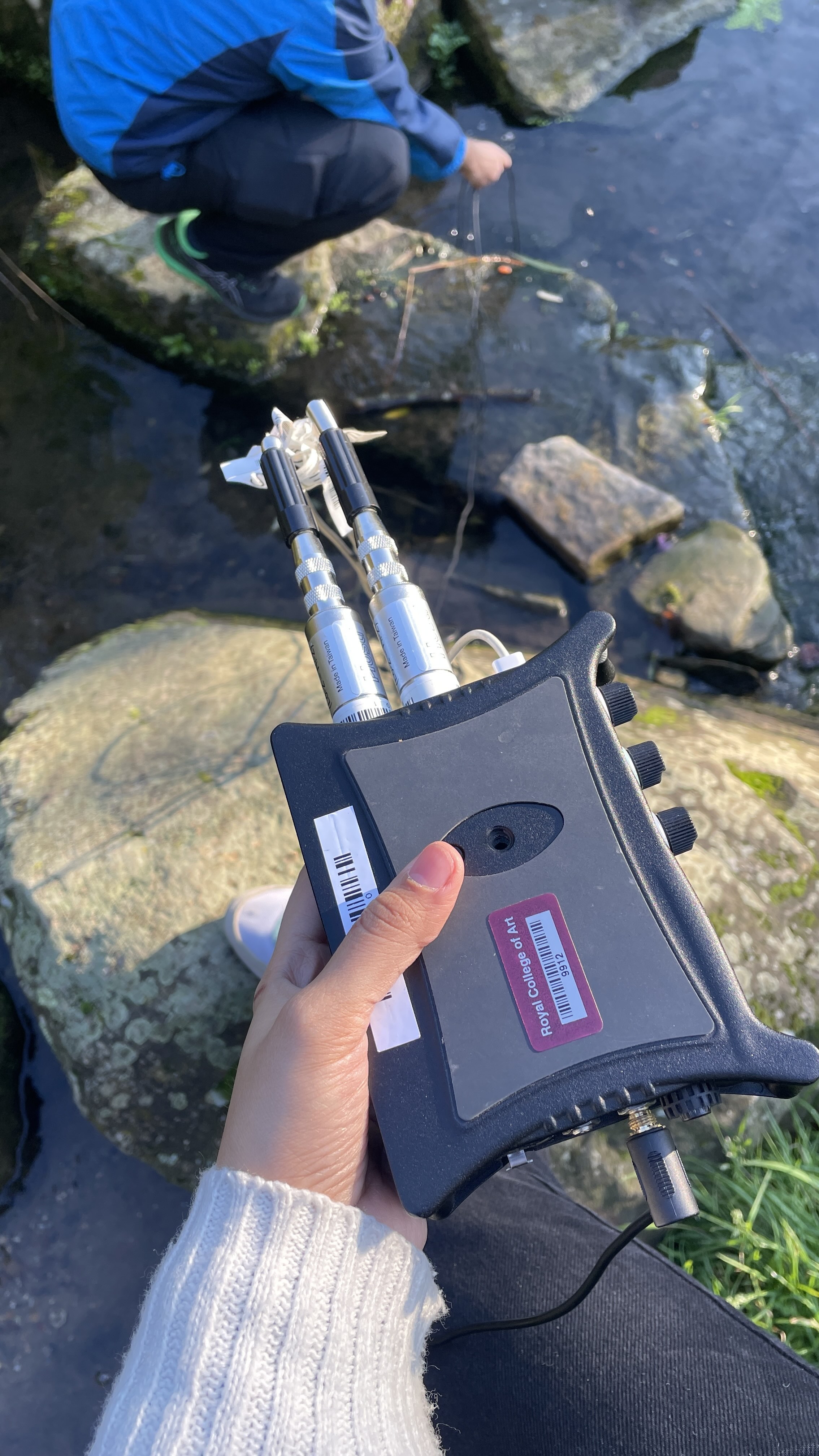Whale Fall
Extended Reality
Interactive Design
Ed-Tech
Whale Fall is an immersive experience designed to raise awareness about marine plastic pollution and its devastating impact on whales. Developed in collaboration with the UK-based Whale and Dolphin Conservation (WDC), the project employs the poetic metaphor of a 'whale fall' to highlight the interconnectedness of life and the urgent need to protect our oceans.
A 'whale fall' refers to the extraordinary process where a whale's body, after its death, sinks to the ocean floor, creating a unique ecosystem that sustains marine life for decades. This natural phenomenon serves as a critical reminder of the cycle of life and the delicate balance that must be preserved for nature to thrive.
The UN designates life below water as a crucial but overlooked sustainable development goal. Whales, vital for global marine ecosystems and climate regulation, face threats from plastic pollution and hazards like fishing gear.
A 'whale fall' refers to the extraordinary process where a whale's body, after its death, sinks to the ocean floor, creating a unique ecosystem that sustains marine life for decades. This natural phenomenon serves as a critical reminder of the cycle of life and the delicate balance that must be preserved for nature to thrive.
The UN designates life below water as a crucial but overlooked sustainable development goal. Whales, vital for global marine ecosystems and climate regulation, face threats from plastic pollution and hazards like fishing gear.
→ External Collaborator: Whale and Dolphin Conservation, UK
→ Collaborators: Selin Ozturk, Armelle Mihailescu, Janmejay Singh
→ Showcased at the Outernet Global in London, BBC Television Centre, IRCAM forum in Paris, SXSW London Showcase
→ Finalist at the Terra Carta Design Lab Challenge
The Whale Fall project composed of three individual experiences:
01. Interactive Virtual Reality
The primary experience is an immersive and interactive Virtual Reality (VR) journey. In this VR environment, participants are transported to a vividly rendered deep-sea world where they can witness a whale sinking to the ocean floor. Viewers are invited to walk around the whale, engage with its surroundings, and actively remove the plastic debris entangling it, an act symbolising hope and restoration.
01. Interactive Virtual Reality
The primary experience is an immersive and interactive Virtual Reality (VR) journey. In this VR environment, participants are transported to a vividly rendered deep-sea world where they can witness a whale sinking to the ocean floor. Viewers are invited to walk around the whale, engage with its surroundings, and actively remove the plastic debris entangling it, an act symbolising hope and restoration.


02. 360 Documentary Film
The second part of Whale Fall is a compelling 360° documentary titled Whales and the Plastic Problem. Created in collaboration with experts from Whale and Dolphin Conservation (WDC), the documentary delves into the devastating impact of plastic pollution on the life cycle of cetaceans. In contrast to the immersive and poetic VR experience, this segment adopts a more serious and factual tone, complementing the eerie and reflective atmosphere of the VR journey by providing critical context and actionable insights.
The second part of Whale Fall is a compelling 360° documentary titled Whales and the Plastic Problem. Created in collaboration with experts from Whale and Dolphin Conservation (WDC), the documentary delves into the devastating impact of plastic pollution on the life cycle of cetaceans. In contrast to the immersive and poetic VR experience, this segment adopts a more serious and factual tone, complementing the eerie and reflective atmosphere of the VR journey by providing critical context and actionable insights.


03. Immersive Exhibition
Whale Fall was prominently featured at The Outernet in London. Audiences experienced the whale’s poignant journey, from her fall from the ocean surface to her final resting place on the seabed, culminating in the bloom of life.The cinematic short film was accompanied by a binaural immersive soundscape, amplifying the emotional and sensory depth of the experience.
Whale Fall was prominently featured at The Outernet in London. Audiences experienced the whale’s poignant journey, from her fall from the ocean surface to her final resting place on the seabed, culminating in the bloom of life.The cinematic short film was accompanied by a binaural immersive soundscape, amplifying the emotional and sensory depth of the experience.




The Process
The process and research methodology for the Whale Fall project involved a combination of primary research, secondary research, and creative experimentation and user testing to refine and expand an immersive experience highlighting marine plastic pollution's effects on whales.
Research Methodology
We interviewed experts such as Ed Fox (Whale & Dolphin Conservation, UK), Sonja Eisfeld (marine ecology and plastic pollution researcher), Emma Eastcott (Head of Safe Seas, Whale & Dolphin Conservation, UK), and artist Cassie Vaughan. Field visits to the Natural History Museum and the Whale and Dolphin Conservation (WDC) Head Office further enriched the findings. Secondary research involved consulting academic literature, including How to Speak Whale by Tom Mustill, reports on plastic pollution's impacts on whales, and studies on whale fall ecosystems by Craig R. Smith and Amy R. Baco. Additionally, creative inspirations were drawn from artistic projects and exhibitions, such as the Refik Anadol Exhibition at the Serpentine Gallery, to enhance the project's narrative and visual storytelling.
The process and research methodology for the Whale Fall project involved a combination of primary research, secondary research, and creative experimentation and user testing to refine and expand an immersive experience highlighting marine plastic pollution's effects on whales.
Research Methodology
We interviewed experts such as Ed Fox (Whale & Dolphin Conservation, UK), Sonja Eisfeld (marine ecology and plastic pollution researcher), Emma Eastcott (Head of Safe Seas, Whale & Dolphin Conservation, UK), and artist Cassie Vaughan. Field visits to the Natural History Museum and the Whale and Dolphin Conservation (WDC) Head Office further enriched the findings. Secondary research involved consulting academic literature, including How to Speak Whale by Tom Mustill, reports on plastic pollution's impacts on whales, and studies on whale fall ecosystems by Craig R. Smith and Amy R. Baco. Additionally, creative inspirations were drawn from artistic projects and exhibitions, such as the Refik Anadol Exhibition at the Serpentine Gallery, to enhance the project's narrative and visual storytelling.


Conceptualisation
The target audience for the Whale Fall project includes Gen Z, millennials, and wildlife enthusiasts, with a focus on engaging educational institutions such as higher education schools, colleges, universities, museums, eco-tourism ventures, and marine life preservation organisations. The creative process began with sketches and concept art inspired by artistic and photographic documentation of whales and the ecosystems that form around their carcasses in the deep sea. This led to the development of two cinematic storyboards: one from the perspective of an observer on the ocean floor watching the whale sink and another following the whale closely as it descends, immersing the viewer in the whale-fall experience.
The target audience for the Whale Fall project includes Gen Z, millennials, and wildlife enthusiasts, with a focus on engaging educational institutions such as higher education schools, colleges, universities, museums, eco-tourism ventures, and marine life preservation organisations. The creative process began with sketches and concept art inspired by artistic and photographic documentation of whales and the ecosystems that form around their carcasses in the deep sea. This led to the development of two cinematic storyboards: one from the perspective of an observer on the ocean floor watching the whale sink and another following the whale closely as it descends, immersing the viewer in the whale-fall experience.




3D worldbuilding and Animation
3D worldbuilding utilised Unreal Engine to create an underwater environment rich with aquatic flora, fauna, and elements of a submerged city. Techniques such as modelling, texturing, rigging, and motion work were achieved using C4D and Houdini, with me initially focusing on mastering technical aspects before integrating them into the final experience. Animation showcased the whale's descent and the blooming of aquatic flora around it, developed through guidance from tutorials and technicians.
3D worldbuilding utilised Unreal Engine to create an underwater environment rich with aquatic flora, fauna, and elements of a submerged city. Techniques such as modelling, texturing, rigging, and motion work were achieved using C4D and Houdini, with me initially focusing on mastering technical aspects before integrating them into the final experience. Animation showcased the whale's descent and the blooming of aquatic flora around it, developed through guidance from tutorials and technicians.




Sound Design
In sound design, authentic underwater sounds were recorded using a hydrophone to capture the natural acoustics of the marine environment. These recordings were enhanced with ambisonic mixes created using Reaper and Adobe Audition, creating an immersive audio experience. To further enrich the soundscape, additional resources from the Ocean Alliance Acoustic Library were integrated. In the studio, foley sounds were created to simulate the noise of plastic, emphasising the presence of pollution in the ocean. This combination of real and designed sounds contributed to an engaging and emotionally impactful auditory experience.
In sound design, authentic underwater sounds were recorded using a hydrophone to capture the natural acoustics of the marine environment. These recordings were enhanced with ambisonic mixes created using Reaper and Adobe Audition, creating an immersive audio experience. To further enrich the soundscape, additional resources from the Ocean Alliance Acoustic Library were integrated. In the studio, foley sounds were created to simulate the noise of plastic, emphasising the presence of pollution in the ocean. This combination of real and designed sounds contributed to an engaging and emotionally impactful auditory experience.



User Testing
For VR, testers explored underwater environments in Unreal Engine, evaluating sonic cues, accessibility features like audio descriptions and captions, and two cinematic perspectives – observing from the ocean floor and descending with the whale. The 360-degree documentary was tested across platforms to assess accessibility, streaming quality, scene transitions, sound design, and emotional resonance. Feedback drove improvements in interactivity, accessibility, and narrative engagement, enhancing the project's message on marine plastic pollution and whale conservation.
For VR, testers explored underwater environments in Unreal Engine, evaluating sonic cues, accessibility features like audio descriptions and captions, and two cinematic perspectives – observing from the ocean floor and descending with the whale. The 360-degree documentary was tested across platforms to assess accessibility, streaming quality, scene transitions, sound design, and emotional resonance. Feedback drove improvements in interactivity, accessibility, and narrative engagement, enhancing the project's message on marine plastic pollution and whale conservation.


